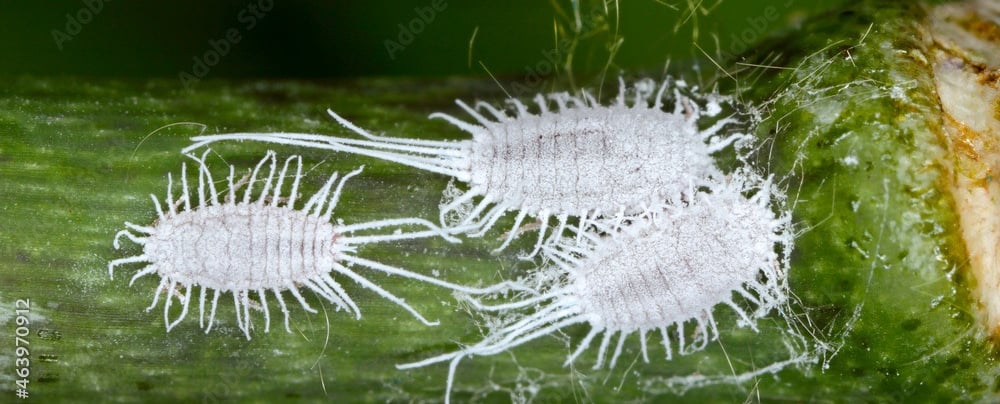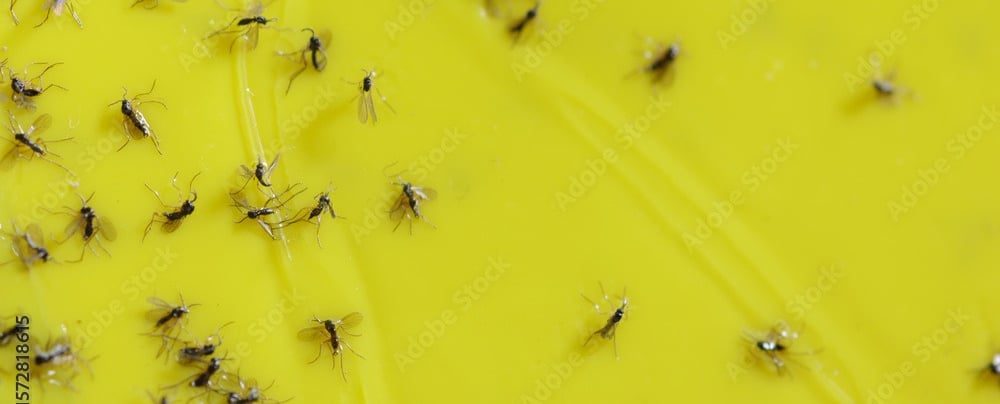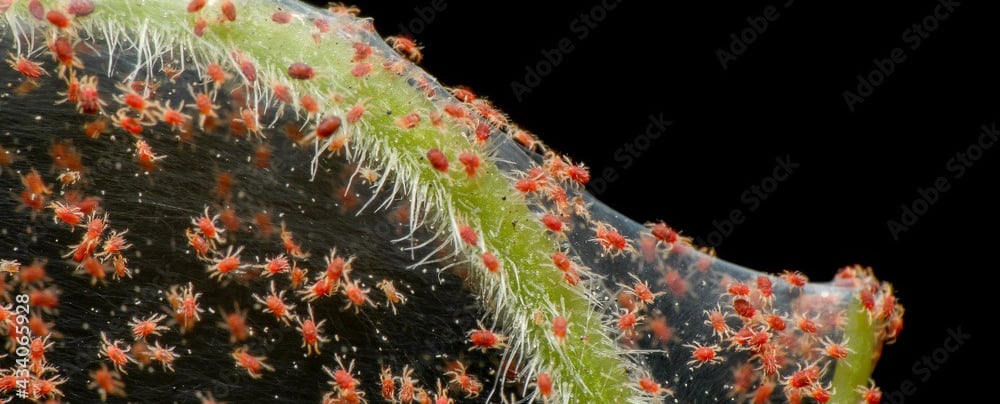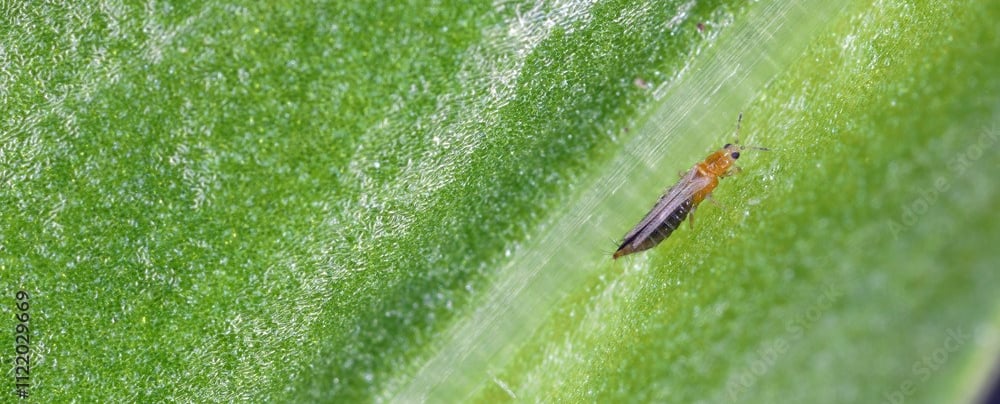Tiny Terrors: The Ultimate Guide to Common Houseplant Pests
How to identify, understand, and banish thrips, spider mites, mealybugs, aphids, and more — for good.


Even the healthiest plants can attract unwanted visitors. Pests like thrips, mealybugs, spider mites, and aphids can appear seemingly overnight — leaving leaves speckled, sticky, and sad.
But don’t panic. With the right knowledge and care, you can spot them early, treat them effectively, and keep your plants thriving.
Early Warning Signs: How to Tell When Pests Are Moving In
Most pests start small — a few pinprick dots, shiny patches, or subtle discolouration. Learning the early warning signs helps you act fast before damage spreads.
1. Sticky Residue (Honeydew)
If your leaves feel tacky or shiny, that’s honeydew — a sugary liquid excreted by sap-sucking pests such as aphids, mealybugs, and scale.
Why it happens: These insects feed on sugary plant sap and excrete the excess.
Clue: Black sooty mould often grows on honeydew, making leaves look dusty.
Fix: Wipe it away with Zero In Dust & Shine Gloves or a damp cloth, then treat the source pest.
2. Silvery or Bronze Streaks
Fine silvery or tan streaks on leaves are signs of thrips. They scrape the leaf surface to feed, leaving behind scars and black specks (droppings).
3. Fine Webbing or Dusty Undersides
Webbing between stems or on undersides of leaves = spider mites. They thrive in warm, dry conditions and leave plants dull and stippled.
4. White Fluff or Cottony Tufts
White “fluff” in leaf joints or under leaves? That’s mealybugs. They look harmless but multiply fast, spreading to nearby plants.
5. Tiny Flies Around Soil
Small black flies hovering near pots are fungus gnats. Adults are harmless, but their larvae eat roots in damp soil.
6. Yellowing, Curling, or Twisted Growth
Distorted leaves, twisted tips, or pale new growth often mean sap-suckers (like aphids or thrips) are draining nutrients from tender shoots.
7.Nature’s Built-In Pest Control
Not all sticky residue comes from pests. Some plants actually produce their own sugary nectar through tiny glands known as extrafloral nectaries, found along leaf stems or undersides.
This nectar acts as a natural bribery system, attracting ants and other beneficial insects who, in exchange for the sugar reward, defend the plant.
Ants patrol the plant, attacking or removing harmful pests such as aphids, mealybugs, or thrips that try to feed on the sap.
It’s one of nature’s cleverest partnerships:
The plant provides food, and the ants provide protection — a living pest-control alliance that keeps ecosystems balanced.
Thrips — The Silent Leaf Shredders
Scientific name: Thysanoptera
Common indoors: Frankliniella occidentalis
Symptoms:
Silvery streaks or speckles on leaves
Deformed new growth
Tiny black dots (frass)
Life cycle:
Eggs laid inside leaves
Larvae feed, then pupate in soil
Adults emerge within 10–20 days
Why They’re Dangerous
Thrips may be tiny, but they cause major damage. Their rasping mouthparts scrape the surface of leaves to suck out cell contents, leaving behind silver scars and distorted new growth. Over time, this weakens the plant’s ability to photosynthesise, stunts growth, and causes leaves to drop.
Thrips can also transmit viral diseases such as the Tospovirus, which causes lasting damage even after the pests are gone.
Treatment:
Isolate the plant.
Rinse leaves and wipe clean.
Spray with insecticidal soap or a strong bug killer.
Replace top 2 cm of soil to remove pupae.
Prevention:
Maintain humidity around 50–70% with airflow.
Inspect new plants under bright light.
Use Sticky Traps near shelves.
🌿 Thrips might love a warm, sunny spot, but they hate a breeze — good airflow is your best secret weapon against them.
Spider Mites — The Invisible Web Weavers
Scientific name: Tetranychus urticae
Symptoms:
Webbing on leaf joints and undersides
Dull, stippled leaves that yellow and drop
Why They’re Dangerous
Spider mites feed by piercing plant cells and draining out their contents. This causes chlorosis — yellow, speckled leaves that eventually turn brown and crisp. Because mites reproduce so quickly (females can lay hundreds of eggs in a few weeks), even a small infestation can overwhelm a plant fast.
Left untreated, they can cause severe leaf drop and even kill young or stressed plants.
Treatment:
Increase humidity — mites hate it.
Rinse foliage under lukewarm water.
Spray with horticultural oil or neem oil — this works by coating the mites’ bodies and blocking their ability to breathe through their exoskeleton, effectively suffocating them.
Prevention:
Keep air moving.
Mist plants or use humidifiers.
Regularly wipe dust off leaves.
Mealybugs — The Cottony Invaders
Scientific family: Pseudococcidae
Symptoms:
White fluff at leaf nodes
Sticky leaves and honeydew residue
Why They’re Dangerous
Mealybugs are slow-moving but extremely persistent. They pierce stems and leaf veins, sucking out sap and leaving plants weak and sticky. Their honeydew encourages sooty mould, which blocks light and slows photosynthesis.
Heavy infestations can lead to stunted growth, leaf loss, and yellowing — and since they often hide in crevices and roots, they can silently spread to other plants before you notice.
Treatment:
Dab visible bugs with alcohol-soaked cotton.
Spray with insecticidal soap or neem oil.
Apply insecticide for severe cases.
Check roots for “root mealies” and repot if needed.
Prevention:
Inspect new plants.
Avoid over-fertilising (soft growth attracts pests).
Aphids — The Classic Sap-Suckers
Scientific family: Aphididae
Symptoms:
Clusters on new shoots and buds
Sticky leaves and distorted growth
Why They’re Dangerous
Aphids don’t just sap energy from your plants — they inject toxins as they feed, causing twisted and curled new growth. They reproduce at lightning speed, creating dense colonies that can deform entire shoots within days.
Like thrips, they also spread plant viruses and attract ants through their sticky honeydew, creating a self-sustaining cycle that’s hard to break.
Treatment:
Rinse the plant thoroughly under lukewarm water to dislodge colonies.
Mix a mild washing-up liquid solution (a few drops per litre of water) and wipe or spray the leaves. The soap breaks down the waxy protective coating on the aphids’ soft bodies, causing them to dehydrate and die.
Follow up with a Bug Killer to prevent reinfestation.
Wipe away any sticky residue to discourage ants and mould.
Prevention:
Avoid excessive fertiliser.
Check underside of leaves weekly.
Keep sticky traps nearby to catch early arrivals.
Fungus Gnats —The Tiny Soil Flies
Scientific family: Sciaridae
Symptoms:
Small black flies over soil
Wilting in seedlings or small plants
Why They’re Dangerous
Adult gnats are harmless, but their larvae feed on decaying matter and delicate root hairs, especially in seedlings or moisture-loving plants.
This can cause root rot, stunted growth, and sudden collapse, particularly in young or recently repotted plants.
A persistent infestation also signals overwatering or poor drainage, which can invite other pests and fungal diseases.
Treatment:
Let soil dry between waterings.
Use Sticky traps.
Add LECA or gravel top layer.
Prevention:
Avoid over-watering .
Keep LECA to break the life cycle to deter larvae.
The Science of Stronger Leaves: How Silicon Helps Plants Fight Back
Most houseplant owners focus on feeding with NPK fertilisers — but silicon is the quiet hero your plants are craving.
While not traditionally classed as an essential nutrient, silicon plays a vital role in strengthening a plant’s natural defences.
When absorbed through the roots, silicon is deposited into the plant’s cell walls, forming a thin, glass-like layer known as silica phytoliths.
This microscopic armour makes leaves and stems:
Tougher and more rigid, reducing physical damage and wilting
Harder for pests like thrips, spider mites, and aphids to pierce with their mouthparts
More resilient to environmental stress like heat, drought, or overwatering
Less prone to fungal infections, as stronger cell walls help block pathogen entry
For variegated plants, silicon can be even more valuable. The white or pale sections of leaves lack chlorophyll, making them weaker and more prone to collapse or damage.
Regular use of Liquid Silicon helps these delicate areas stay firm, bright, and beautifully defined — keeping your variegation crisp and your foliage healthier overall.
🌱 Think of silicon as your plant’s internal scaffolding — invisible, but essential for keeping every leaf strong, upright, and pest-resistant.










At-Risk Plants: Who Attracts What (and Why)
No two plants attract pests in the same way — some are magnets for trouble, while others rarely get touched. Knowing which pests target which plants helps you stay one step ahead and protect your collection before problems spread.
Monsteras (like deliciosa, dubia, and Thai Constellation) are often targeted by thrips, mealybugs, and scale, thanks to their large leaves and sheltered nodes that offer the perfect hiding spots. Variegated types are especially vulnerable, as their pale tissue is softer and easier for pests to pierce.
Philodendrons — particularly favourites like Florida Beauty, Melanochrysum, and Gloriosum — attract thrips, aphids, and sometimes spider mites. Their tender new leaves and velvety surfaces make ideal feeding grounds, and thrips love hiding inside the unfurling growth.
Alocasias, such as Frydek, Black Velvet, and Lauterbachiana, are notorious for hosting spider mites and mealybugs. Their love of warmth and humidity creates perfect breeding conditions, while their thick stems trap moisture where pests can thrive unseen.
Anthuriums like Veitchii and Crystallinum also fall prey to thrips and mealybugs. Their glossy, nutrient-rich foliage provides the perfect surface for sap-suckers, and new leaves emerging from tight sheaths are particularly at risk.
Calatheas and Marantas (the “prayer plants”) are spider mite magnets when air gets too dry. Their thin, delicate leaves show damage quickly, and mites multiply rapidly if humidity drops.
Begonias, with their soft stems and sugary sap, often attract aphids and mealybugs — especially when densely grown, as their canopies offer shelter for colonies.
Pothos and Epipremnums are another pest favourite. Fast-growing and full of tender new growth, they can quickly develop thrips, scale, or mealybug problems, particularly in trailing or climbing displays where pests can move between leaves unnoticed.
Aglaonemas (like Pictum Tricolor) tend to suffer from mealybugs, which love their smooth, fleshy stems and protected undersides.
Peace Lilies (Spathiphyllum) also attract aphids and mealybugs, especially on their glossy flower spathes and new shoots where sap flow is strongest.
Succulents and cacti, while hardy, are vulnerable to mealybugs in dry indoor conditions. These pests tuck themselves into crevices and under areoles where they’re almost invisible.
Lastly, Orchids can harbour aphids and spider mites, particularly along flower spikes and leaf joints, where soft new tissue is rich in sap.
🌿 Hector’s Haven Tip: If you have several plants from the same family — like a row of Alocasias or a group of Philodendrons — pests can spread between them easily. Quarantine new plants for 7–10 days before adding them to your main collection. It’s the best prevention method there is.
Bringing It All Together
Pests can be frustrating, but with the right knowledge, care, and tools, you can keep your plants healthy and thriving all year round. Most infestations start small — and catching them early makes all the difference.
Remember: strong, well-fed plants are naturally more resistant to pests. Products like Botanixx Liquid Silicon, Provanto Ultimate Bug Killer, and Soil Ninja Blends help create the perfect growing environment — making your plants tougher, more vibrant, and less inviting to unwanted guests.
If you ever need guidance, don’t hesitate to reach out — we’re always happy to help. Whether it’s identifying a mystery pest, recommending a care routine, or choosing the right product for your setup, you can count on us to guide you.
Need advice or supplies?
Explore our full range of plant care essentials — from pest treatments to soil blends.
Together, we’ll keep your plants strong, glossy, and pest-free — because every leaf deserves a little haven of its own. 🌱
